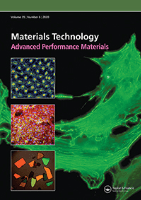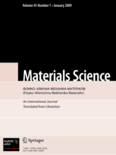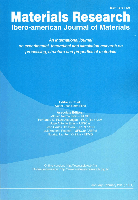
MATERIALS TECHNOLOGY
Scope & Guideline
Advancing the Frontiers of Materials Science
Introduction
Aims and Scopes
- Advanced Material Synthesis and Characterization:
The journal publishes research on novel synthesis methods for materials, including nanoparticles, composites, and bio-materials, focusing on their structural, optical, and mechanical properties. - Biomedical Applications:
A significant scope includes studies on materials designed for biomedical applications, such as drug delivery systems, wound healing, and biocompatibility of implants, showcasing the integration of materials science with healthcare. - Nanotechnology and Nanomaterials:
Research on nanomaterials, including their synthesis, characterization, and application in various fields such as electronics, energy storage, and environmental remediation, remains a core area of focus. - Energy Materials:
The journal emphasizes materials for energy applications, including photovoltaics, batteries, and fuel cells, highlighting innovative approaches to enhance efficiency and sustainability. - Environmental and Green Materials:
A growing area of interest is the development of eco-friendly materials and sustainable synthesis processes, including the use of bio-sourced materials and green chemistry techniques. - Computational Modeling and Simulation:
The integration of computational methods to predict material behavior and performance is a key aspect, aiding experimental findings and guiding the design of new materials.
Trending and Emerging
- Green Synthesis and Biogenic Materials:
There is a notable increase in studies focusing on environmentally friendly synthesis methods for nanoparticles and materials, utilizing plant extracts and sustainable processes. - Smart and Multifunctional Materials:
Research on smart materials, including stimuli-responsive and multifunctional materials for applications in sensors, drug delivery, and biomedical devices, has gained significant momentum. - Energy Storage and Conversion Technologies:
The emergence of advanced materials for energy storage and conversion, particularly in batteries and supercapacitors, is a prominent trend, driven by the demand for sustainable energy solutions. - 3D Printing and Additive Manufacturing:
The application of materials in 3D printing and additive manufacturing technologies is increasingly popular, reflecting a shift towards personalized and efficient manufacturing processes. - Nanomedicine and Targeted Therapies:
A growing focus on nanomedicine, particularly the use of nanoparticles for targeted drug delivery and cancer therapy, showcases the intersection of materials science and healthcare. - Computational Materials Science:
The integration of computational techniques, including machine learning and molecular dynamics, to predict material properties and optimize designs is emerging as a critical area of research.
Declining or Waning
- Traditional Bulk Material Studies:
Research focused primarily on traditional bulk materials without innovative methodologies has decreased, as the field shifts towards nanostructured and advanced materials. - Conventional Coatings and Surface Treatments:
Studies on basic surface treatments and conventional coatings are less frequent, with a growing preference for multifunctional and smart coatings that provide additional benefits. - Standard Material Testing and Characterization:
Publications centered solely on standard mechanical testing or characterization methods without novel insights or applications have shown a decrease, as interdisciplinary approaches gain traction. - Metallurgy and Alloy Development:
While metallurgy remains important, there has been a noticeable decline in research focused exclusively on traditional alloy systems without the integration of advanced processing or applications. - Non-Eco-Friendly Synthesis Routes:
Research involving non-eco-friendly synthesis methods is declining, reflecting a broader trend towards sustainability and environmental considerations in materials science.
Similar Journals

Journal of Optoelectronic and Biomedical Materials
Advancing Innovation in Healthcare TechnologiesJournal of Optoelectronic and Biomedical Materials (ISSN: 2066-0049) is a peer-reviewed academic journal published by the renowned VIRTUAL INSTITUTE OF PHYSICS, dedicated to advancing research in the interdisciplinary fields of optoelectronics and biomedical materials. This journal aims to provide a platform for researchers, professionals, and students to disseminate their findings on innovative materials and technologies that harness optical and electronic properties for biomedical applications. With an increasing significance in medical diagnostics, therapeutic approaches, and advanced materials science, the Journal of Optoelectronic and Biomedical Materials underscores the importance of facilitating collaboration among scientists from diverse fields. While currently operating under a traditional access model, the journal aspires to enhance global accessibility to cutting-edge research contributions that will drive the future of technology in healthcare and biotechnology. As a growing reference point in its domain, it encourages submissions that can advance these crucial scientific areas.

MATERIALS SCIENCE
Unveiling the Science Behind Tomorrow's Materials.MATERIALS SCIENCE, a prominent journal published by SPRINGER, serves as a vital resource for researchers, professionals, and students in the fields of materials science, mechanical engineering, and condensed matter physics. With its ISSN 1068-820X and E-ISSN 1573-885X, this journal has been dedicated to sharing innovative research since its inception in 1993, and it continues to publish groundbreaking findings through 2024. Although it operates as a traditional subscription-based journal, its ranking in the Q3 quartile across multiple scientific categories, including Condensed Matter Physics, Materials Science, Mechanical Engineering, and Mechanics of Materials, signifies its relevance and impact in the academic community. Notably, its Scopus classifications reveal a competitive standing among its peers, ranking within the 25th to 33rd percentiles across various engineering and physics disciplines. The journal remains a key platform for disseminating valuable insights, fostering collaboration, and advancing the understanding of materials science.

Accounts of Materials Research
Advancing the frontiers of materials science.Accounts of Materials Research is a premier journal published by the American Chemical Society, focusing on the multidimensional field of materials science. With a robust impact factor and a commitment to open-access research, it serves as a vital platform for leading-edge discoveries from 2020 to 2024. The journal has rapidly ascended to the top quartile in multiple categories, including Chemical Engineering, Materials Chemistry, and Polymers and Plastics, demonstrating its significant influence within the academic community. Recognized by Scopus as a key resource—with remarkable rankings that place it in the 95th percentile of its field—Accounts of Materials Research is devoted to publishing high-quality, innovative research that addresses critical challenges in materials development and implementation. This journal is essential for researchers, professionals, and students seeking to stay informed about the latest advancements and collaborative opportunities within the interdisciplinary landscape of materials science.

Nanoscience and Technology-An International Journal
Exploring the Frontiers of Nanoscience and TechnologyNanoscience and Technology-An International Journal, published by BEGELL HOUSE INC, is a leading platform dedicated to the rapidly evolving fields of nanoscience and nanotechnology. With its ISSN 2572-4258 and E-ISSN 2572-4266, the journal serves as a crucial resource for researchers, professionals, and students alike, focusing on advanced materials, condensed matter physics, and mechanics of materials. It holds a commendable position in the scholarly community, evidenced by its Q2 ranking in 2023 across multiple categories including Condensed Matter Physics and Materials Science. The journal aims to disseminate high-quality research, promote interdisciplinary collaboration, and facilitate innovation within the nano realm. With its convergence period from 2019 to 2024, it continues to attract a diverse array of studies and insightful contributions, reinforcing its importance in shaping the future of nanotechnology and its applications.

Korean Journal of Materials Research
Fostering Collaboration for Materials ExcellenceKorean Journal of Materials Research is a pivotal publication in the field of materials science, offering a platform for innovative research and comprehensive reviews in miscellaneous materials applications. Published by the MATERIALS RESEARCH SOC KOREA, this journal has been a valuable resource since its inception in 2007 and continues to disseminate vital findings through 2024. Although currently categorized in Q4 of the Materials Science quartiles, the journal is committed to advancing knowledge and fostering research collaboration within the scientific community. With an ISSN of 1225-0562 and an E-ISSN of 2287-7258, the journal aims to bridge gaps in research and practice, appealing to a diverse audience of researchers, professionals, and students interested in the latest advancements in materials science. While access to content may not be open, the journal's impact in the regional and global research landscape is steadily growing, as indicated by its Scopus ranking in the 7th percentile of General Materials Science. Engage with the Korean Journal of Materials Research to stay at the forefront of materials innovation!

JOURNAL OF ELECTRONIC MATERIALS
Elevating Knowledge in Condensed Matter Physics and BeyondWelcome to the Journal of Electronic Materials, a premier publication in the field of materials science. Published by Springer, this esteemed journal has been a beacon for groundbreaking research in electronic, optical, and magnetic materials since its inception in 1972. As an established resource, it boasts a commendable impact factor and categorically ranks in the second quartile (Q2) in key areas such as Condensed Matter Physics and Electrical and Electronic Engineering, as well as holding a respectable third quartile ranking in fields related to Electronic, Optical, and Magnetic Materials and Materials Chemistry. Researchers, professionals, and students can access a wealth of knowledge as we publish original articles, reviews, and cutting-edge research that push the boundaries of science and technology in these critical fields. Stay informed and engaged as we explore advancements that shape the future of electronic materials.

Materials Research-Ibero-american Journal of Materials
Bridging theory and practice in the realm of materials technology.Materials Research-Ibero-american Journal of Materials, published by the UNIV FED SAO CARLOS, DEPT ENGENHARIA MATERIALS, is a prominent platform dedicated to advancing the field of materials science. Launched in 1998, this Open Access journal has fostered a culture of inclusive knowledge sharing, allowing researchers and practitioners worldwide to access valuable insights in Condensed Matter Physics, Materials Science, Mechanical Engineering, and Mechanics of Materials. With a commendable Q3 ranking in these diverse categories in 2023, the journal provides a vital resource that bridges theoretical research and practical applications in materials technology. Covering a range of topics from novel material characterization to innovative engineering solutions, Materials Research serves as a critical forum for contributors across the globe, particularly those in Latin America. Researchers, students, and professionals are encouraged to engage with this journal, which operates with a clear commitment to high standards and is based in São Carlos, Brazil, further enhancing its relevance and appeal within the international materials research community.

Materials Today Advances
Unlocking innovations in materials and mechanical engineering.Materials Today Advances is a premier open access journal, published by Elsevier, dedicated to disseminating cutting-edge research in the fields of Materials Science and Mechanical Engineering. Since its inception in 2019, the journal has quickly established itself within the academic community, achieving an impressive Q1 quartile ranking in both disciplines as of 2023, indicative of its high-impact contributions. Ranked #25 out of 672 in Mechanical Engineering and #46 out of 463 in General Materials Science according to Scopus, Materials Today Advances offers rigorous peer-reviewed articles that address the latest innovations and interdisciplinary approaches. Researchers, professionals, and students can benefit from the journal's open access model, ensuring widespread visibility and accessibility of groundbreaking findings. With the convergence of advanced materials research and practical applications, this journal represents a vital resource for those at the forefront of scientific discovery.

ACS Materials Au
Bridging Knowledge Gaps in Materials ChemistryACS Materials Au, published by the American Chemical Society, is a premier open-access journal that has been at the forefront of materials science since its inception in 2021. With an ISSN of 2694-2461, this journal encompasses an expansive range of topics including biomaterials, electronic, optical and magnetic materials, materials chemistry, and polymers and plastics, consistently achieving Q1 rankings in these categories for 2023. The journal is based in the United States and operates from the AMS's headquarters in Washington, DC, offering significant visibility and a robust platform for researchers. The journal's commitment to open access ensures wide dissemination of groundbreaking research, enabling a diverse audience—including researchers, professionals, and students—to engage with the latest advancements in materials science. With an encouraging impact factor and a focus on novel materials and innovative applications, ACS Materials Au stands as a vital resource for anyone devoted to understanding and advancing the frontiers of materials engineering and science.

JOURNAL OF CLUSTER SCIENCE
Unveiling Complexities in Cluster PhenomenaJOURNAL OF CLUSTER SCIENCE, published by SPRINGER/PLENUM PUBLISHERS, is a prominent and influential journal in the fields of Biochemistry, Chemistry, Condensed Matter Physics, and Materials Science. With an ISSN of 1040-7278 and E-ISSN of 1572-8862, this journal has been contributing to scientific discourse since its inception in 1990 and continues to publish cutting-edge research through 2024. It holds a respectable position in the academic landscape with its category quartiles indicating a Q3 ranking in Biochemistry and Q2 rankings in Chemistry, Condensed Matter Physics, and Materials Science as of 2023. The journal's noteworthy Scopus rankings further underscore its relevance, particularly a rank of #82 in Condensed Matter Physics, showcasing its impact and the quality of research disseminated. Although it does not currently offer open access options, it remains a key resource for researchers, professionals, and students who are invested in understanding the complexities of cluster science and its interdisciplinary applications.